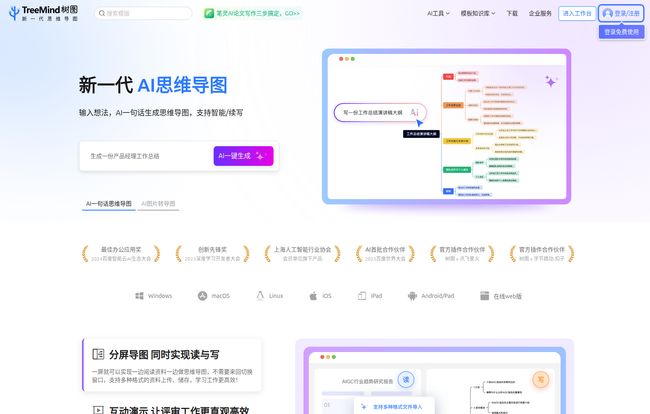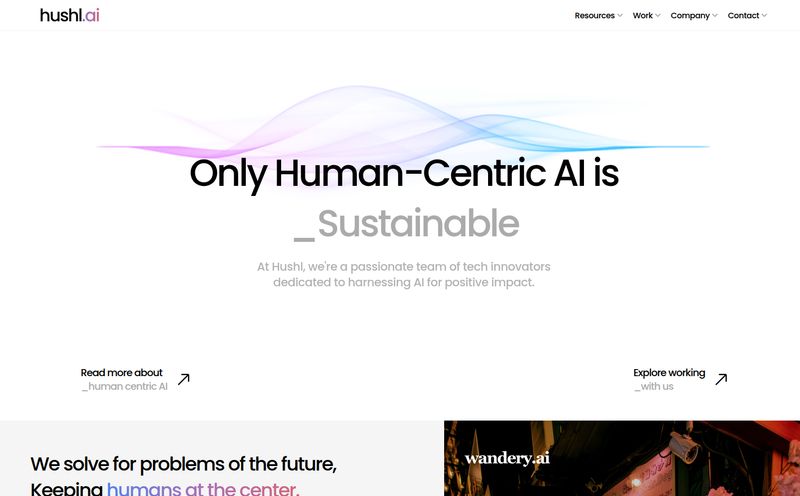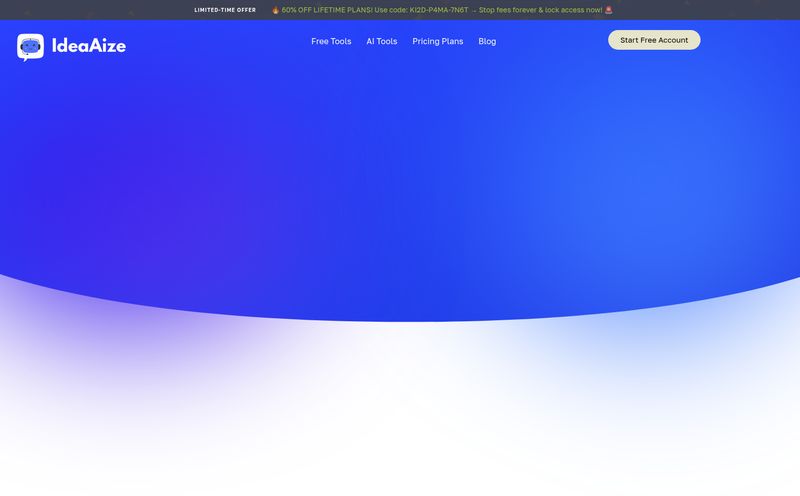For years, my brainstorming process has been… chaotic. We're talking sticky notes colonizing my monitor, sprawling whiteboards that look like a Jackson Pollock painting, and a dozen half-finished Google Docs all screaming for attention. It's a mess. A creative mess, sure, but a mess nonetheless.
I've always been a huge fan of mind mapping. The act of visually connecting ideas is how my brain works. But the traditional tools? Some felt clunky, like using Microsoft Paint to design a skyscraper. Others were just glorified flowchart makers. So when I kept hearing whispers about AI getting into the mind mapping game, my interest was definitely piqued.
Enter TreeMind. The name itself is pretty on-the-nose, right? But the promise is huge: an AI-powered mind mapping tool that does the heavy lifting for you. But does it live up to the hype, or is it just another tech gimmick? I had to find out.
So, What Exactly is TreeMind?
At its core, TreeMind is an online mind mapping software. But that's like saying a smartphone is just a pocket calculator. The secret sauce is the integrated AI. It's designed to take your raw, jumbled thoughts and structure them into beautiful, logical diagrams. Think of it less as a blank canvas and more as a smart assistant that helps you brainstorm.
It supports all the classic formats you’d expect: traditional mind maps, logic diagrams, org charts, timelines, and even those fishbone diagrams that always pop up in business textbooks. The goal here isn't just to make pretty charts, it's about accelerating the entire process from initial idea to a fully fleshed-out plan.
The AI Features That Genuinely Impressed Me
This is where things get interesting. I'm naturally skeptical of anything that slaps an "AI" label on it. I’ve seen too many “smart” tools that are anything but. TreeMind, however, has a few tricks up its sleeve that feel genuinely useful.
From a Single Sentence to a Full Mind Map
This is the headline feature, and for good reason. You can literally type in a single prompt—like "Marketing plan for a new coffee shop"—and the AI will generate a whole mind map. It builds out branches for things like Target Audience, Product Offerings, Social Media Strategy, and Local SEO. Is it perfect? No. But as a starting point? It's phenomenal. It blasts you past that dreaded "blank page syndrome" and gives you a solid framework to start editing and adding your own genius to. It's like having a junior strategist on call 24/7.

Visit TreeMind
#
Turning Images and Docs into Brain Dumps
Two other features really stood out. First, the Image to Mind Map function. You can upload a photo—say, of a whiteboard from a team meeting—and it will try to convert the text and structure into a digital mind map. The accuracy can vary, but its a huge time-saver compared to re-typing everything manually.
Second, and this is a big one for me, is the Document Summarization. You can feed it a long article, a research paper, or a report, and it will pull out the key themes and create a mind map summary. For anyone who has to digest dense information regularly, this is an absolute game-changer. It visualizes the document's structure, making it so much easier to grasp the main arguments and how they connect.
#
Beyond the AI: Core Strengths That Matter
Collaboration That Doesn't Suck
I once tried to co-plan a content calendar using a shared mind map file that we had to email back and forth. It was a disaster. Version control went out the window, and we spent more time merging changes than actually planning. TreeMind has real-time collaboration, and it works just like you'd hope. You can see your teammates' cursors moving around, adding nodes, and leaving comments. It turns a static diagram into a living, breathing workspace. This is a non-negotiable feature for any modern team, and they've implemented it well.
A Template for Literally Everything
The site claims to have over 120,000 templates, which sounds like a marketing exaggeration, but the library is massive. Whether you're doing a SWOT analysis, planning a novel, or mapping out a software development cycle, there's probably a template for it. This is a huge efficiency booster. Instead of building a structure from scratch, you pick a template, and you're already halfway there. You can just focus on the ideas themselves.
The Good, The Bad, and The AI-Generated
No tool is perfect, right? After playing around with TreeMind for a while, here's my honest breakdown.
What I loved is the sheer speed. The AI generation and templates cut down the initial setup time to almost zero. The cross-platform syncing is also smooth; I could start an idea on my desktop and tweak it on my tablet without a hitch. And the fact that there's a free version means there's no barrier to just trying it out, which I always appreciate.
However, there are a few things to keep in mind. You are, to some extent, relying on the AI's accuracy. Sometimes its interpretation of a document or a prompt can be a little… weird. You still need your human brain to review and refine its output. Don't expect it to write a business plan for you. Also, with so many features packed in, there can be a slight learning curve to find everything and use it to its full potential. And, like with most freemium models, I'd expect the really powerful features to be limited in the free version.
#
So, What's the Price Tag?
This is the million-dollar question. As of my review, specific pricing tiers weren't immediately available on their site. This is pretty common for tools that might be A/B testing plans or have regional pricing. What we do know is that TreeMind offers a free version. This is great because you can get a real feel for the platform's core functionality before ever pulling out your wallet. My advice? Sign up for the free account and see how it fits into your workflow. You'll know pretty quickly if upgrading to a potential paid plan is worth it for you.
Who is TreeMind Actually For?
I can see a few groups getting a ton of value out of this.
- Students & Researchers: The document summarization feature alone is worth its weight in gold for tackling dense academic papers.
- Project Managers: Great for mapping out project phases, creating org charts, and using timelines to visualize deadlines. The collaboration is key here.
- Content Creators & Marketers: I've already used it to map out a quarterly content strategy. It's brilliant for turning a single keyword idea into a whole cluster of related topics.
- Anyone with a Brain Full of Ideas: Honestly, if you're a visual thinker who feels overwhelmed by the sheer number of ideas bouncing around in your head, this tool can act as an external hard drive for your brain.
#
My Final Thoughts on TreeMind
So, is TreeMind the end of brainstorming as we know it? No, and that's a good thing. It doesn't replace human creativity; it augments it. It's a powerful catalyst that handles the tedious structural work, freeing you up to do what you do best: think, create, and connect the dots in novel ways.
It’s one of the first AI tools I've used that feels less like a robot and more like a partner. It's not magic, but for clearing the mental clutter and getting ideas down in a structured way, it's pretty darn close. If you're tired of the sticky note explosion, I’d say giving TreeMind a spin is a no-brainer.
Frequently Asked Questions
Is TreeMind really free to use?
Yes, TreeMind offers a free version that allows you to access its basic mind mapping and AI features. There will likely be premium paid plans with more advanced capabilities, but you can get started and create useful maps without paying.
How good is TreeMind's AI at creating mind maps?
It's surprisingly good as a starting point. The AI is excellent for generating a solid structure and initial ideas from a single prompt. However, you'll still need to apply your own expertise and critical thinking to refine, edit, and add nuance to the generated map.
Can I use TreeMind with my team?
Absolutely. One of its strongest features is real-time collaboration. Multiple users can edit the same mind map simultaneously, making it a great tool for team brainstorming sessions, project planning, and remote work.
What kind of diagrams can I make besides mind maps?
TreeMind is quite versatile. Beyond standard mind maps, it supports logic diagrams, tree diagrams, organizational charts, timelines, and fishbone (Ishikawa) diagrams for cause-and-effect analysis.
Does TreeMind work on different devices?
Yes, it's designed with cross-platform synchronization. This means you can create or edit your mind maps on a desktop computer and then access and continue working on them from a tablet or another device, with your files staying in sync.
Reference and Sources
For more information or to try the tool yourself, you can visit the official website:



